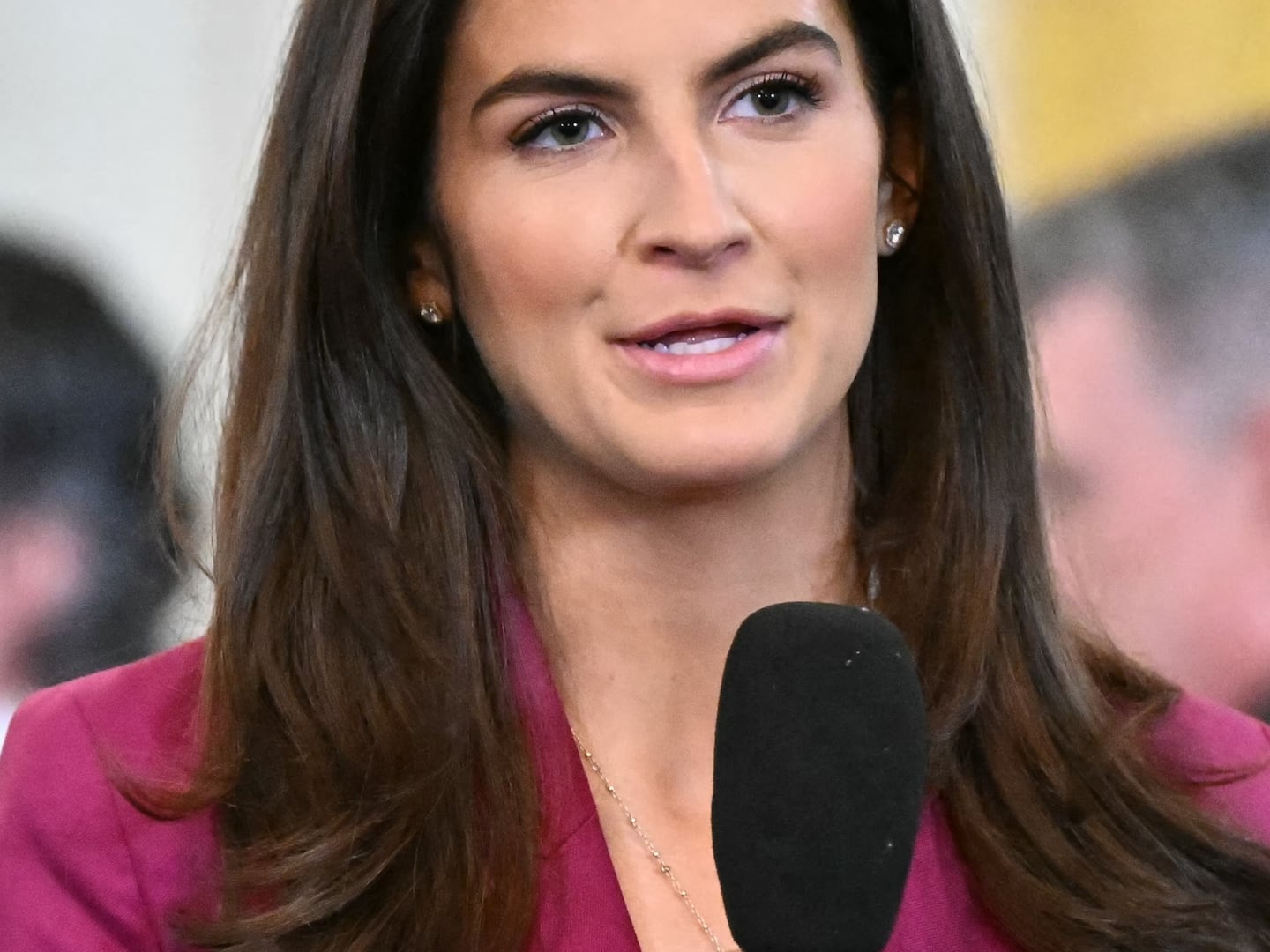As a longtime traveler to the post-Soviet space I thought that I had long since gotten used to the odd juxtapositions of entertainment and commercials that one sees on Russian television. A viewer can be watching a Soviet-era WWII movie where a general speechifies about the need to defeat the capitalists and then there is a cutaway to a commercial for Colgate toothpaste. Nothing, however, prepared me for the bizarre spectacle that I watched one September evening on REN-TV while sitting in a country that borders Russia.
REN is notorious for its tabloidish propaganda productions. One of its programs, Voina Tayna (The Secret War), frequently engages in anti-American and anti-Western polemics and does so in a way that would make Joseph Goebbels proud. On the particular evening that I watched the list of targets for nationalistic anti-American outrage was seemingly endless—the U.S. Agency for International Development, American pop stars such as Taylor Swift and Justin Bieber (who is Canadian), Barbie dolls, Coca-Cola, Santa Claus, American pharmaceuticals, even the song “Happy Birthday” were all a part of a seemingly bottomless list of pernicious American influences on Russia.
One segment was devoted to the heroic efforts of the “Texas separatist movement.” Most disturbing of all was that the footage was punctuated with many tight shots of angry and downright nasty looking people of color shaking their fists or just looking like they are plotting to kill, including that most famous American of color of all, President Obama. A segment on Kentucky Fried Chicken’s conquest of the world started with a group of fried chicken-eating bare chested African-American men whose eyes popped in a D.W. Griffith fashion that was downright shocking.
Yet, when it came time for commercials, I watched an array of ads featuring European and American companies, including the previously reviled Coca-Cola. The REN-TV channel also broadcasts another program, Secret World, that is hosted by former spy Anna Chapman, which centers on the paranormal. The fact that the hostess was expelled from the U.S. for espionage doesn’t seem to get in the way of business as her show also has familiar American and European brand-name advertisers.
REN-TV is owned by National Media Group, which is controlled by Yuri Kovalchuk, a longtime associate of President Vladimir Putin’s going back to his St. Petersburg days. Kovalchuk is, along with Putin, a co-founder of the Ozero dacha cooperative and is the largest shareholder in Bank Rossiya, which was organized by the Kremlin elite in order to hold their assets.
Kovalchuk is on the U.S. Treasury and European Union’s sanctions list. The Treasury refers to him as a “Putin advisor,” a banker for Putin, and also mentions his popular moniker, “Putin’s cashier.” The European Union placed Kovalchuk on their sanctions list specifically because of his media and propaganda activities. NMG’s official chairwoman is Alina Kabayeva, who is widely believed to be Putin’s paramour.
How is it that American companies have come to be sponsoring a program designed to instill fear of all things American in the Russian public during these already heated times on a channel controlled by a sanctioned Putin crony?
I spoke with Vasily Gatov, a Russian media researcher who used to work at REN-TV in the 1990s before Kovalchuk took it over. He went on to become Deputy CEO at the RIA/Novosti press agency until the Kremlin took total control over it and reorganized it as Rossiya Syevodnya. He now lives in Boston, where he is writing a book on censorship in Russia.
Gatov explained to me that in order to understand this situation one needs to first understand that television advertising in Russia does not operate like television advertising in a normal market economy.
The TV ad industry in Russia is a duopoly. There are two large television advertising firms in Russia—Video International, which is mostly owned by Kovalchuk, and Gazprom Media-Acatraz, which is owned by Gazprombank, which is controlled by Kovalchuk. Together the two firms control two-thirds of the Russian advertising market. There are smaller advertising agencies in Russia, but in order to book time on Russian TV networks they need to use a software program that is licensed by Video International.
I told Gatov that it sounded like it was impossible to advertise on Russian television without putting money into Kovalchuk’s pockets somehow. He said, “Yes, you can barely avoid it.”
A company could conceivably choose not to advertise on Russian TV at all, but that is never really an option for a consumer products company. In 2011, a group of foreign companies—fed up with having little say over how their products were marketed as well as with high advertising costs—banded together to demand greater competition in the TV advertising industry. But, according to a commentator, the effort failed when a prominent foreign firm refused to go along.
National Media Group owns two other TV channels besides REN-TV. Gazprom Media has a stake in five TV channels. A company can thus work with a Kovalchuk-controlled agency to buy ad time on a Kovalchuk-controlled TV channel.
As if that is not enough, a new Russian media law that is now taking effect mandates that all media operating in Russia can have a maximum of only 20 percent foreign stakeholders. This has enabled Kovalchuk to further expand his media empire by forming Russian-based companies with the Discovery Channel and Turner Broadcasting/CNN.
If Kovalchuk is on the sanctions lists and American companies are doing business with him then one would think they are violating sanctions laws. However, that’s not necessarily the case.
The U.S. sanctions Kovalchuk as an individual, and also sanctions his Bank Rossiya, but does not sanction any of his television or advertising firms. American companies also do not usually buy advertising from their home offices. They do it through European and Russian subsidiary companies that are not subject to the U.S. sanctions laws (they would be in the case of sanctions against Iran). Gatov says that on average there are three intermediaries between an American firm and a Russian television channel. European subsidiaries would be under the purview of European Union sanctions law.
Also on the sanctions list is the notoriously xenophobic and homophobic Dmitry Kiselyev, who is a regular commentator on Russia’s Channel 1. He is also the director of the aforementioned Rossiya Syevodnya news service. When Putin spoke at the United Nations in late October, Kiselyev’s programs were filled with all kinds of nationalistic propaganda. Nevertheless, a number of American companies advertised on those very same programs.
I reached out to several companies whose ads I saw run on the segment of REN’s Voina Tayna. Procter & Gamble replied by “respectfully declining” the opportunity to discuss the issue with me. Coca-Cola and Mars failed to reply to several emails and phone calls.
One company that did reply was Johnson & Johnson. They confirmed that their ad did run in the country that I viewed the segment in, but denied that it had run in Russia itself. That was indeed the case. They declined to respond to my questions about whether they are cutting back on their TV advertising in Russia at all or otherwise re-examining their TV advertising policies with respects to Russia.
So what’s the harm here? One of Putin’s rich associates and Putin’s other hanger-ons get a steady source of income with ad dollars generated with the brand image of American companies. Putin’s associates have another source of reliable income besides oil. So what?
As anyone who follows Russia knows, Putin is positively obsessed with what Russians see on television. Early on in his reign he installed his most trusted cronies like Kovalchuk in positions of leadership at previously independent television networks in order to be able to shape what the Russian public knows.
Even with the advent of the Internet, television is still most Russians’ prime source of information, especially in the countryside. Certainly it’s not all propaganda—most television programming in Russia doesn’t involve anything remotely political. Indeed, American culture both good and bad can be found on various television stations.
Nevertheless, television is still the tool the Putin regime uses to “whip-up the base,” which in this case means pensioners, lower-class workers, poorly educated people, and country folk. They’re inclined to believe most anything about the enemy of the month be it Americans, Ukrainian, gay people, the West in general, or now Turks.
Furthermore, Russian television isn’t just watched in Russia. In many neighboring countries, Russian television is still the primary source of news and entertainment. So, the propaganda campaigns extend beyond Russia’s borders. At a time when tensions are already running high, channels such as REN-TV are openly stirring the pot and keeping things tense, thereby increasing the risk of a conflict.
The dilemma has not gone completely unnoticed by the companies in questions. Kraft foods has removed advertisements for its products from Russian TV. Procter & Gamble is reportedly now only advertising products that it sells only in Russia on television, such as Mif laundry detergent. Those products would not generally be recognizable as Procter & Gamble products to any Americans who happen to be watching Russian television.
A Russian executive who did not wish to be identified for this piece resigned from one iconic American company in part because he was uncomfortable with the tenor of the programs his firm was advertising on. In December, Rossiya 24 carried a nationalistic “documentary” called Myroporyadok (“World Order”) that had only advertisements from Russian companies with the sole exception of Nestle.
There has been much discussion in Washington about how best to counter the Kremlin’s propaganda efforts. Much of the debate has focused on increasing funding to counter it through Voice of America and Radio Liberty/Radio Free Europe. There has also been talk of trying to ban the ineffectual RT (formerly Russia Today) television network in the U.S., which is constitutionally dubious and would do nothing to affect Russian public opinion.
There has been no discussion at all surrounding the ad dollars that American and European companies pour into the Russian media that in turn makes the propaganda campaign possible in the first place.
Without those ad dollars it would be difficult for Russian media to function. Nor has there been any examination of media business deals. Perhaps it is time to examine whether the sanctions regime should be strengthened to shut off the Western advertising money spigot for the Kremlin propaganda machine provided advertisers themselves don’t do it first.






